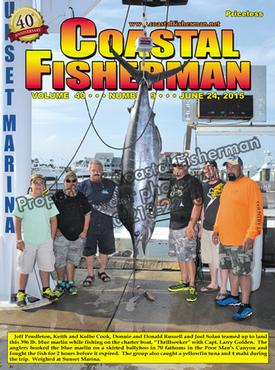


Article by Capt. Steve Katz
 Temperamental
Temperamental
Temperature
The definition of temperamental is “unpredictable in behavior or performance”. Is that how your seawater temperature display operates? If so, continue reading because we will review how the seawater temperature display operates and how to improve your readings.
For many fishermen, the seawater temperature display is just as important as their other fishing gear. Seawater temperature plays a significant role in the behavior of our local game fish. Different species of fish have a defined temperature range in which they feel most comfortable. Since most fish can not regulate their own temperature, they need to move to water that meets their temperature range. Even subtle changes in temperature will affect the behavior of fish. In some cases, a degree or two can alter the feeding habits of a species without causing them to leave the area. The angler who knows the temperature range of the fish he/she is fishing for has an advantage by heading to the area that has the appropriate water temperature.
What’s the best way to measure water temperature? Well, that depends on your boat and electronic systems available.
The simplest way to measure seawater temperature is to use a thermometer, yes, and a standard hardware store style outdoor thermometer at that. This can be lowered into the seawater or placed in a circulating live well or similar location. While not necessarily exciting, this “old school” method is inexpensive, accurate and reliable.
The most popular method to measure seawater temperate is through the modern electronic sonar display. Most sonar/fishfinder/sounder displays have the ability to indicate temperature readings digitally, in numbers or even in graph form. The actual temperature reading comes from within the depth transducer. Most depth transducers that are designed to be installed on the transom or thru-hull of a boat has a thermistor or (thermal resistor) built-in. The resistance is dependent on seawater temperature, generally decreasing as the water temperate increases. The fishfinder display will “read” the information from the transducer and convert it to a digital temperature reading displayed on the fish finder.
Another popular system to have is an independent temperature probe connected to your existing electronic displays. For instance, if you have an in-hull or shoot-thru traducer, the face of the transducer does not contact the water and is therefore unable to accurately measure seawater temperature without a separate temperature transducer. This optional temperature sensor can be a thru-hull device or even a small transom mounted sensor. These sensors are usually connected to the sounder machine in a special ‘Y”cable or spliced into the existing depth transducer wiring.
Another popular method is to use a “smart sensor” from Airmar (the transducer manufacturer). A smart sensor measures the resistance of the thermistor and processes the resultant data inside the unit itself, not reliant a specific display. The smart transducer then sends the temperature along the standard marine communication data wiring using NMEA0183 or NMEA2000.
The NMEA2000 sensor is a simple and easy way to add a primary or secondary temperature data collection device to your boat. The NMEA2000 data can then be connected to almost any NMEA2000 compatible device, such as a modern chartplotter or stand-alone, multifunction display. The cost is about $300 for the transducer.
While it was the most popular method years ago, the stand alone Dytek seawater temperature gauge has disappeared from store shelves and has been replaced by a few other brands of stand-alone temperature gauges. Displays such as the CruzPro WTP65 or SI-TEX SST-110, are nice units, with each costing less than $400 with a transducer.
If your boat is equipped with modern electronics, the stand-alone NMEA2000 temperature thru-hull sensor is a nice addition since it allows you to display seawater temperature anywhere on the NMEA200 network. These sensors are not brand specific, so they are not tied to any particular display device and even allow simultaneous displays.
Once you install your new temperature gauge or fine tune your existing gauge, you may need to calibrate the gauge display. For example, most Furuno sounders have a set-up page that allow you to adjust the temperature readout +/- a few degrees. In order to do this you need an accurate secondary measurement of the water, such as an outdoor thermometer, for comparison purposes.
Why isn’t the seawater temperature gauge working? If the reading is too high or too low, a simple adjustment in the display may be all you need. If you do not have a temperature reading on your chartplotter, and you did in the past, there could be something wrong with the wiring or transducer. If you have an Airmar transducer, there is a chart that lets you measure the resistance of the thermistor wiring and compare it to the actual temperature to see if you have a problem. Adding a transom mount temperature sensor is also a quick and simple solution for those without a transducer that can measure temperature.
While there are other methods of measuring and predicting seawater temperature, such as SSTOL.com, Sirius/XM satellite sea surface readings or buoy readings, knowing the exact water temperature where your boat is fishing can help you target and catch more fish.
Captain Steve Katz is the owner of Steve’s Marine Service and holds NMEA, AMEI and NMEA2000 certificates along with ABYC Master Technician certification and factory training from many manufacturers.